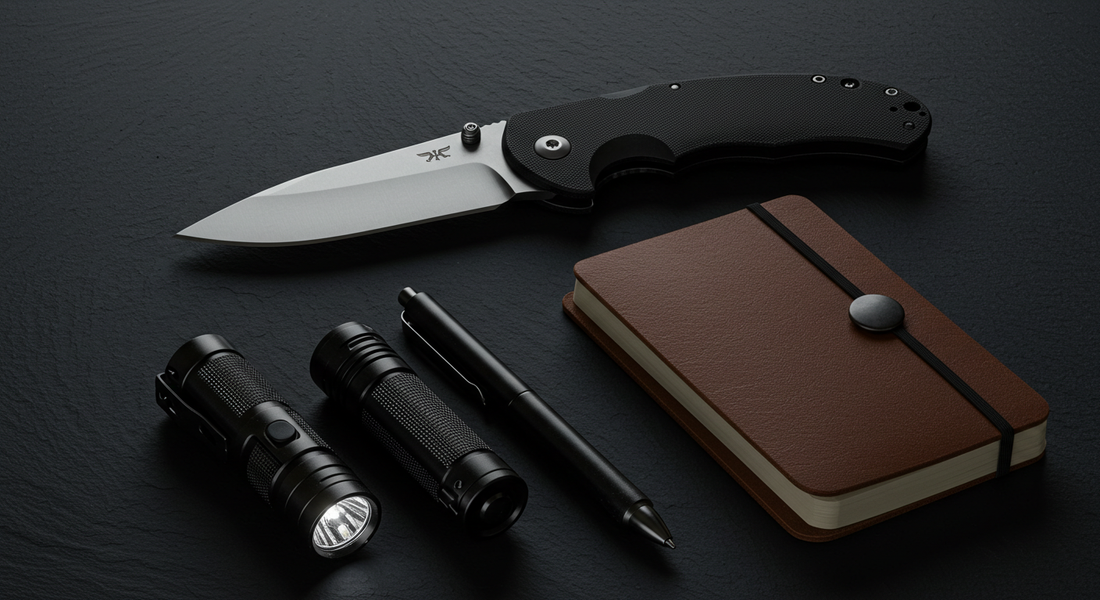
Everyday Carry (EDC) 101: How to Build Your Core Pocket Toolkit
Share

You've probably heard the term "EDC" in online communities or seen pictures of carefully arranged pocket gear. But what is EDC? At its core, Everyday Carry is a philosophy of preparedness and self-reliance. It’s not about doomsday prepping; it’s about being equipped to handle the small, common, everyday emergencies and inconveniences that life throws your way—from opening a stubborn package to navigating a power outage or tightening a loose screw. This beginner EDC guide will help you build a practical pocket toolkit of everyday carry essentials that will give you a quiet confidence to handle whatever the day brings.
The Core Four: Your EDC Foundation
You don't need to carry a backpack full of gear. A solid EDC starts with a few key items that provide the most utility. This is your foundation.
-
A Reliable Folding Knife: This is the cornerstone of most EDC kits. A good quality folding knife is an incredibly versatile tool for tasks like opening boxes, cutting cordage, or slicing an apple for lunch.
-
A Compact Flashlight: The flashlight on your phone is a battery-draining backup, not a primary tool. A small, dedicated LED flashlight is brighter, more durable, and won't drain your communication device. It’s invaluable for finding something you dropped under a car seat, looking in a dim closet, or navigating a dark street during a power outage.
-
A Multi-Tool: A compact multi-tool (like a Leatherman Squirt or a Victorinox Swiss Army Knife) puts a toolbox in your pocket. Having instant access to pliers, screwdrivers, and a bottle opener can solve a surprising number of daily problems.
-
A Pen and Small Notebook: While we live in a digital world, the ability to quickly jot down a note, a license plate number, or an idea without fumbling for your phone is incredibly useful. A durable pen and a pocket-sized notebook are analog reliability at its finest.
Level 2: Expanding Your Capabilities
Once you have your Core Four, you can add a few more items to expand your capabilities without adding significant bulk.
-
A Minimalist First-Aid Kit: You don't need a full trauma kit, but a small pouch with a few adhesive bandages, antiseptic wipes, and pain relievers can be a lifesaver for the minor cuts and scrapes that are a part of life.
-
A Portable Power Bank: In our tech-driven world, a dead phone can be a real emergency. A slim, lipstick-sized power bank can provide a crucial charge to keep you connected.
-
A Personal Safety Alarm: For those who walk alone at night or want an extra layer of security, a personal safety alarm is a small device that emits a piercingly loud sound to attract attention and deter potential threats.
How to Carry It All
How you carry your EDC is a matter of personal preference.
-
Pocket Organization: The simplest method is to dedicate specific pockets for your gear. This keeps things consistent and easy to access.
-
EDC Pouches and Sling Bags: For those who carry a bit more, a small EDC pouch can keep all your gear neatly organized in one spot, ready to be dropped into a backpack or carried on its own. A small sling bag is another excellent option for keeping your pockets free.
Legal and Practical Considerations
It is crucial to be a responsible EDC practitioner.
-
Understand Local Knife Laws: Knife laws vary dramatically from city to city and state to state. Before you carry a knife, you must research your local regulations regarding blade length, locking mechanisms, and concealed carry. Ignorance of the law is not an excuse.
Conclusion: A Personalized, Evolving System
Your EDC is a personal and constantly evolving system. What works for one person might not work for another. Start with the Core Four, and over time, you'll learn what you use, what you don't, and what you wish you had. The goal isn't to be weighed down with gear; it's to be equipped with a few high-quality tools
